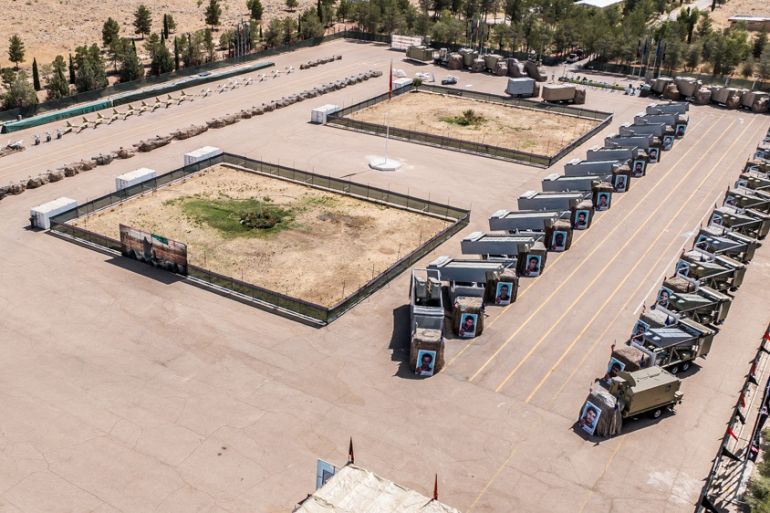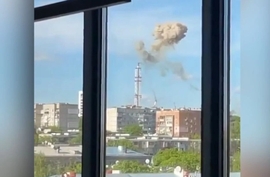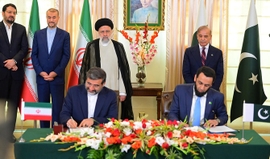The Islamic Revolution Guards Corps' (IRGC) Navy has received new strategic systems and weapons including missiles, drones and electronic warfare systems.
"A variety of cruise missile launch trucks along with radar and command systems and several hundred cruise and ballistic missiles with a range of 300 to 1000 km are also among the systems and equipment that were added to the capabilities of the IRGC navy today", Iran’s Tasnim News Agency reported on August 5.
The IRGC Commander-in-Chief Hossein Salami and Navy Commander Alireza Tangsiri attended the ceremony held on August 5 to unveil and hand over the equipment to the navy.
Various types of reconnaissance, intelligence, offensive and combat drones, different types of support and command vehicles, offensive and defensive systems in the field of electromagnetic warfare were among the new products that were unveiled.
The production of these systems and equipment is the result of the efforts of scientists and specialists of the Aerospace Industries Organisation, the Maritime Industries Organisation, the Aerospace and Electronic Industries Organisation of the Ministry of Defence, as well as knowledge-based companies, the private sector, and specialised centres of the IRGC Navy, according to Tasnim.
The IRGC Navy also took delivery of Ghadir and Nasir cruise missiles. With a range of up to 300 kilometres, Ghadir (CM-300) missile is widely used in coastal launchers and naval combat vessels. It uses an inertial guidance system for its initial phase and active radar guidance for its final phase.
Ghadir missile weighs 700 kilograms and is comprised of a 165-kilogram warhead. The missile receives the position of sea targets from radars and moves toward them using an internal guidance system or inertia based on the accelerometer and gyroscope. After reaching the target, the missile locks onto it while guided by an active radar.
Nasir (CM-90) missile has a turbojet engine and a maximum range of 90 kilometres. It can be launched from coastal and marine platforms. Weighing 351 kilograms, the missile is capable of carrying a 130-kilogram warhead at a maximum speed of Mach 8, which is 8 times the speed of sound.
The IRGC navy received these strategic systems and weapons, a few days after the force held drills near the three disputed islands - Greater Tunb, Lesser Tunb, and Abu Musa - in the Gulf, controlled by Iran but claimed by the United Arab Emirates (UAE).
The exercises began on August 2 with a focus on Abu Musa - the furthest south of the three islands and only 60 km from the coast of the United Arab Emirates (UAE).
The goal of the drills "was to show the authority and defensive preparedness of the IRGC Navy to protect the security of the Persian Gulf and Iranian islands," according to the IRNA news agency.
On August 6, Iran's Supreme Leader Ayatollah Ali Khamenei praised a navy flotilla that returned home on May 17 after completing an eight-month journey worldwide, describing their journey as a "great pride".
In an address to the personnel and families of Flotilla 86 of the navy of Iran's regular army, Khamenei said the successful mission proved that international waters "belong to everyone" and any country that intends to prevent the passage of "this and that ship" from waterways is "mistaken".
The supreme leader also condemned the "violations of international maritime laws" in the region and beyond by the USA and accused Washington of "harassing oil tankers and helping smuggling groups" at sea.
Maritime tensions have spiked between Iran and the US in recent years off Iran's southern coasts. The Persian Gulf and the Strait of Hormuz have witnessed several attacks on tankers in recent years, often occurring during periods of heightened regional tensions with Iran.
In November 2022, the US Navy’s 5th Fleet, based in Bahrain, released details and photos of its investigation into the attack on the Liberian-flagged Pacific Zircon tanker. The investigation revealed that the Shahed-136 drone caused a 30-inch-wide (76 cm) hole in the back of the ship, damaging a shipboard boiler, potable water tank, and life raft.







 President Ilham Aliyev shed light on the evolving contours of the peace process with Armenia during an international conference in Baku this week. ...
President Ilham Aliyev shed light on the evolving contours of the peace process with Armenia during an international conference in Baku this week. ...
 Azerbaijan and Armenia started the process of demarcation of their border on Tuesday, with the installation of the first border markers based on ge...
Azerbaijan and Armenia started the process of demarcation of their border on Tuesday, with the installation of the first border markers based on ge...
 Armenian sappers commenced on Monday mine-clearance operations in the territories adjacent to the Saint Mary Church in village of Voskepar (Armenia...
Armenian sappers commenced on Monday mine-clearance operations in the territories adjacent to the Saint Mary Church in village of Voskepar (Armenia...
 Iran and Pakistan have signed eight cooperation documents in various fields, and agreed to strengthen ties to fight terrorism in the region.
Iran and Pakistan have signed eight cooperation documents in various fields, and agreed to strengthen ties to fight terrorism in the region.
 As the conflict between Ukraine and Russia escalates, the strategic importance of Kharkiv, Ukraine's second-largest city, has come sharply into focus.
As the conflict between Ukraine and Russia escalates, the strategic importance of Kharkiv, Ukraine's second-largest city, has come sharply into focus.
 President Aliyev emphasized the critical role of the North-South Transport Corridor in fostering transport cooperation between Azerbaijan and Russi...
President Aliyev emphasized the critical role of the North-South Transport Corridor in fostering transport cooperation between Azerbaijan and Russi...



